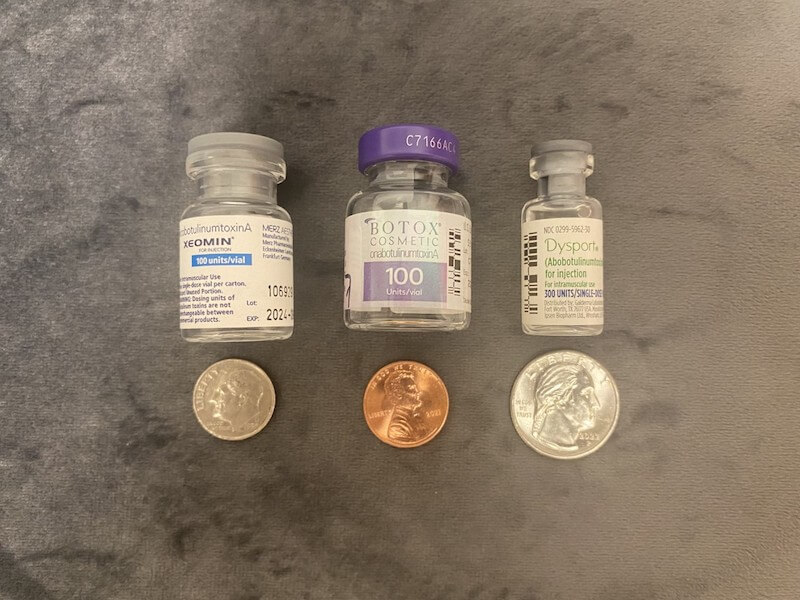Written by Amanda Olsen, PA-C
Believe it or not, your skin starts to age once you hit your mid-20s to early 30s. Around this time you will notice fine lines and wrinkles beginning to form. While these wrinkles are a normal part of the aging process, anti-aging treatments like neurotoxins can help boost your self-confidence while also working to prevent further signs of aging. But what is the difference between neurotoxins like Botox, Xeomin, and Dysport? And why is one wrinkle relaxer recommended to you over another?
Botox vs. Xeomin vs. Dysport Similarities
To start, all three neurotoxins are derived from Clostridium Botulinum type A. These injectable neuromodulators block nerve signals relaxing the facial muscles. Botox, Xeomin, and Dysport, on average, last 3-4 months. Duration of your toxin will depend on your metabolism and treatment dosage (or the number of units you receive). All three are excellent options to reduce the appearance of frown lines, crow’s feet, and deep forehead lines without surgical intervention. Botox, Xeomin and Dysport are all non-invasive anti-aging treatments to help reduce the appearance of fine lines and wrinkles.
Botox vs. Xeomin vs. Dysport Differences
The biggest differences between Botox, Xeomin, and Dysport seem to be the lack of additive proteins, the amount of dispersion once injected, and how quickly the results begin to take effect.
Botox and Dysport have complexing proteins that surround the toxin, whereas Xeomin has no additional proteins. This lack of additional proteins decreases the chance of the body producing an allergic reaction or neutralizing antibodies when treated with Xeomin. Additive proteins are meant to clump together to help the effects of the toxin last longer. Be aware, patients with a specific egg or lactose protein allergy should avoid Dysport because of the presence of the allergen protein in this neurotoxin.
Xeomin spreads the least under the skin – about a dime size, Botox – about a penny, and Dysport spreads the most – about a quarter. The more the toxin spreads, the more units you will need in the injected area.

Some patients feel that Xeomin and Dysport have a quicker onset than Botox, however there is no clinical proof that one neurotoxin works more quickly than others. On average most of our Xeomin patients notice the effects of the toxin within 2 days post treatment, Dysport within 2-3 days, and Botox within 4-5 days. However, it can in some cases take longer than a week to see the complete effects from a neurotoxin treatment. We advise all our patients to return 2 weeks post injection to ensure they have achieved the desired result from their anti-aging injectable treatments.
Why are Botox, Xeomin, and Dysport important anti-aging treatments?
All three of these neurotoxins are great for dynamic lines that are caused by movements such as: crinkling your eyes, raising your eyebrows, dimpling your chin, or smiling. When we move our facial muscles, fine lines and wrinkles appear as a result.
When we’re younger and have ample collagen and elastin, our skin can snap back into place with no visible signs of wrinkles. As we age, this production of collagen and elastin reduces (almost by half by the time you are in your early 30s!) and allows those wrinkles to set in. If you have reached the point where your skin no longer “snaps back into place”, you will want to begin to start using consistent neurotoxin treatments to stop the muscles from contracting to allow the skin time to repair itself.
Are neurotoxins considered a corrective or preventative anti-aging treatment?
Younger patients (20-30s) can use neurotoxins as a preventative treatment to relax the muscles before any damage has been done. More mature patients (40s and above) can utilize neurotoxin treatments as a form of corrective treatment – to help decrease the amount of damage that has already been done. However, whether you’re seeking these products for preventive or corrective help, consistent, regular treatments yield the best results!
Our PA-C injector, Amanda, creates a customized treatment plan for each patient based on their prior toxin experience, past medical history, personal preferences, and her professional recommendation. A treatment plan might consist of one or all three of these neurotoxins! The best way to figure out which toxin (or toxins) is right for you, is to come in for a complimentary consultation!